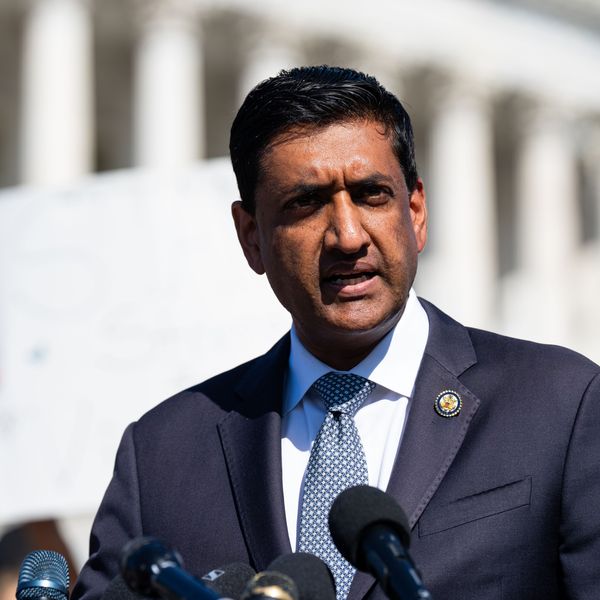'Brown at 60': Segregation Plaguing US Schools: Report
In past 60 years, some progress has been made, but education inequities remain endemic, finds UCLA report
Six decades after the formal desegregation of U.S. schools, segregation along lines of race and class continues to plague nation-wide education, according to a report released Thursday by the UCLA's Civil Rights Project/Proyecto Derechos Civiles.

Entitled Brown at 60: Great Progress, a Long Retreat and an Uncertain Future, the study finds that Black and Latino students are more likely to be enrolled in poor schools than their White and Asian counterparts--who are more likely to be found in middle-class schools.
Segregation is the worst in the "central cities of the largest metropolitan areas," according to a report summary.
New York, Illinois, and California share the dubious title of worst in the nation for segregating Black youth. California is also number one for isolating Latino students.
"The growth of segregation has been most dramatic for Latino students, particularly in the West, where there was substantial integration in the l960s, and segregation has soared," states the report. In suburban areas, Latino students are more segregated than their Black counterparts.
The study points to some areas of progress: "Contrary to many claims, the South has not gone back to the level of segregation before Brown. It has lost all of the additional progress made after l967 but is still the least segregated region for Black students."
Yet Gary Orfield, co-author of the study and co-director of the Civil Rights Project,
declared in a statement released Thursday, "It is time to stop celebrating a version of history that ignores our last quarter century of retreat and begin to make new history by finding ways to apply the vision of Brown in a transformed, multiracial society in another century,"
_____________________
An Urgent Message From Our Co-Founder
Dear Common Dreams reader, The U.S. is on a fast track to authoritarianism like nothing I've ever seen. Meanwhile, corporate news outlets are utterly capitulating to Trump, twisting their coverage to avoid drawing his ire while lining up to stuff cash in his pockets. That's why I believe that Common Dreams is doing the best and most consequential reporting that we've ever done. Our small but mighty team is a progressive reporting powerhouse, covering the news every day that the corporate media never will. Our mission has always been simple: To inform. To inspire. And to ignite change for the common good. Now here's the key piece that I want all our readers to understand: None of this would be possible without your financial support. That's not just some fundraising cliche. It's the absolute and literal truth. We don't accept corporate advertising and never will. We don't have a paywall because we don't think people should be blocked from critical news based on their ability to pay. Everything we do is funded by the donations of readers like you. Will you donate now to help power the nonprofit, independent reporting of Common Dreams? Thank you for being a vital member of our community. Together, we can keep independent journalism alive when it’s needed most. - Craig Brown, Co-founder |
Six decades after the formal desegregation of U.S. schools, segregation along lines of race and class continues to plague nation-wide education, according to a report released Thursday by the UCLA's Civil Rights Project/Proyecto Derechos Civiles.

Entitled Brown at 60: Great Progress, a Long Retreat and an Uncertain Future, the study finds that Black and Latino students are more likely to be enrolled in poor schools than their White and Asian counterparts--who are more likely to be found in middle-class schools.
Segregation is the worst in the "central cities of the largest metropolitan areas," according to a report summary.
New York, Illinois, and California share the dubious title of worst in the nation for segregating Black youth. California is also number one for isolating Latino students.
"The growth of segregation has been most dramatic for Latino students, particularly in the West, where there was substantial integration in the l960s, and segregation has soared," states the report. In suburban areas, Latino students are more segregated than their Black counterparts.
The study points to some areas of progress: "Contrary to many claims, the South has not gone back to the level of segregation before Brown. It has lost all of the additional progress made after l967 but is still the least segregated region for Black students."
Yet Gary Orfield, co-author of the study and co-director of the Civil Rights Project,
declared in a statement released Thursday, "It is time to stop celebrating a version of history that ignores our last quarter century of retreat and begin to make new history by finding ways to apply the vision of Brown in a transformed, multiracial society in another century,"
_____________________
Six decades after the formal desegregation of U.S. schools, segregation along lines of race and class continues to plague nation-wide education, according to a report released Thursday by the UCLA's Civil Rights Project/Proyecto Derechos Civiles.

Entitled Brown at 60: Great Progress, a Long Retreat and an Uncertain Future, the study finds that Black and Latino students are more likely to be enrolled in poor schools than their White and Asian counterparts--who are more likely to be found in middle-class schools.
Segregation is the worst in the "central cities of the largest metropolitan areas," according to a report summary.
New York, Illinois, and California share the dubious title of worst in the nation for segregating Black youth. California is also number one for isolating Latino students.
"The growth of segregation has been most dramatic for Latino students, particularly in the West, where there was substantial integration in the l960s, and segregation has soared," states the report. In suburban areas, Latino students are more segregated than their Black counterparts.
The study points to some areas of progress: "Contrary to many claims, the South has not gone back to the level of segregation before Brown. It has lost all of the additional progress made after l967 but is still the least segregated region for Black students."
Yet Gary Orfield, co-author of the study and co-director of the Civil Rights Project,
declared in a statement released Thursday, "It is time to stop celebrating a version of history that ignores our last quarter century of retreat and begin to make new history by finding ways to apply the vision of Brown in a transformed, multiracial society in another century,"
_____________________

